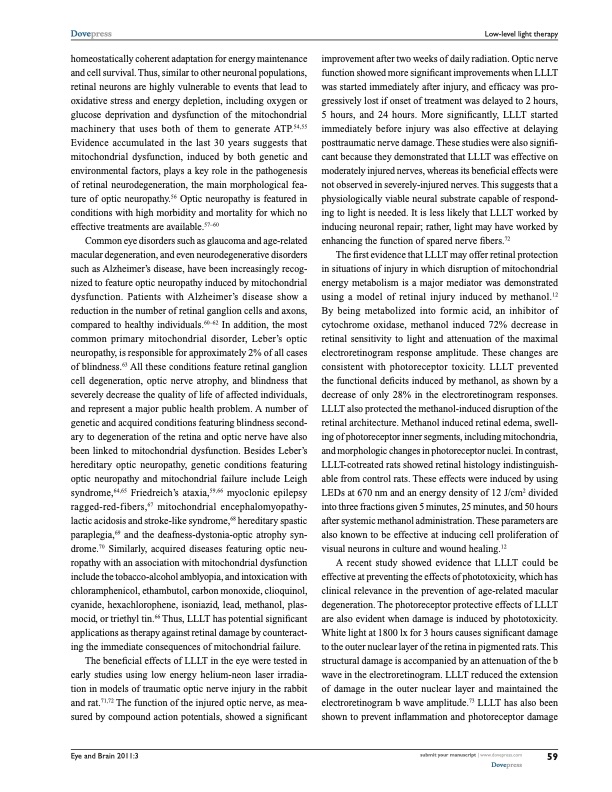
PDF Publication Title:
Text from PDF Page: 011
Dovepress Low-level light therapy homeostatically coherent adaptation for energy maintenance and cell survival. Thus, similar to other neuronal populations, retinal neurons are highly vulnerable to events that lead to oxidative stress and energy depletion, including oxygen or glucose deprivation and dysfunction of the mitochondrial machinery that uses both of them to generate ATP.54,55 Evidence accumulated in the last 30 years suggests that mitochondrial dysfunction, induced by both genetic and environmental factors, plays a key role in the pathogenesis of retinal neurodegeneration, the main morphological fea- ture of optic neuropathy.56 Optic neuropathy is featured in conditions with high morbidity and mortality for which no effective treatments are available.57–60 Common eye disorders such as glaucoma and age-related macular degeneration, and even neurodegenerative disorders such as Alzheimer’s disease, have been increasingly recog- nized to feature optic neuropathy induced by mitochondrial dysfunction. Patients with Alzheimer’s disease show a reduction in the number of retinal ganglion cells and axons, compared to healthy individuals.60–62 In addition, the most common primary mitochondrial disorder, Leber’s optic neuropathy, is responsible for approximately 2% of all cases of blindness.63 All these conditions feature retinal ganglion cell degeneration, optic nerve atrophy, and blindness that severely decrease the quality of life of affected individuals, and represent a major public health problem. A number of genetic and acquired conditions featuring blindness second- ary to degeneration of the retina and optic nerve have also been linked to mitochondrial dysfunction. Besides Leber’s hereditary optic neuropathy, genetic conditions featuring optic neuropathy and mitochondrial failure include Leigh syndrome,64,65 Friedreich’s ataxia,59,66 myoclonic epilepsy ragged-red-f ibers,67 mitochondrial encephalomyopathy- lactic acidosis and stroke-like syndrome,68 hereditary spastic paraplegia,69 and the deafness-dystonia-optic atrophy syn- drome.70 Similarly, acquired diseases featuring optic neu- ropathy with an association with mitochondrial dysfunction include the tobacco-alcohol amblyopia, and intoxication with chloramphenicol, ethambutol, carbon monoxide, clioquinol, cyanide, hexachlorophene, isoniazid, lead, methanol, plas- mocid, or triethyl tin.66 Thus, LLLT has potential significant applications as therapy against retinal damage by counteract- ing the immediate consequences of mitochondrial failure. The beneficial effects of LLLT in the eye were tested in early studies using low energy helium-neon laser irradia- tion in models of traumatic optic nerve injury in the rabbit and rat.71,72 The function of the injured optic nerve, as mea- sured by compound action potentials, showed a significant Eye and Brain 2011:3 improvement after two weeks of daily radiation. Optic nerve function showed more significant improvements when LLLT was started immediately after injury, and efficacy was pro- gressively lost if onset of treatment was delayed to 2 hours, 5 hours, and 24 hours. More significantly, LLLT started immediately before injury was also effective at delaying posttraumatic nerve damage. These studies were also signifi- cant because they demonstrated that LLLT was effective on moderately injured nerves, whereas its beneficial effects were not observed in severely-injured nerves. This suggests that a physiologically viable neural substrate capable of respond- ing to light is needed. It is less likely that LLLT worked by inducing neuronal repair; rather, light may have worked by enhancing the function of spared nerve fibers.72 The first evidence that LLLT may offer retinal protection in situations of injury in which disruption of mitochondrial energy metabolism is a major mediator was demonstrated using a model of retinal injury induced by methanol.12 By being metabolized into formic acid, an inhibitor of cytochrome oxidase, methanol induced 72% decrease in retinal sensitivity to light and attenuation of the maximal electroretinogram response amplitude. These changes are consistent with photoreceptor toxicity. LLLT prevented the functional deficits induced by methanol, as shown by a decrease of only 28% in the electroretinogram responses. LLLT also protected the methanol-induced disruption of the retinal architecture. Methanol induced retinal edema, swell- ing of photoreceptor inner segments, including mitochondria, and morphologic changes in photoreceptor nuclei. In contrast, LLLT-cotreated rats showed retinal histology indistinguish- able from control rats. These effects were induced by using LEDs at 670 nm and an energy density of 12 J/cm2 divided into three fractions given 5 minutes, 25 minutes, and 50 hours after systemic methanol administration. These parameters are also known to be effective at inducing cell proliferation of visual neurons in culture and wound healing.12 A recent study showed evidence that LLLT could be effective at preventing the effects of phototoxicity, which has clinical relevance in the prevention of age-related macular degeneration. The photoreceptor protective effects of LLLT are also evident when damage is induced by phototoxicity. White light at 1800 lx for 3 hours causes significant damage to the outer nuclear layer of the retina in pigmented rats. This structural damage is accompanied by an attenuation of the b wave in the electroretinogram. LLLT reduced the extension of damage in the outer nuclear layer and maintained the electroretinogram b wave amplitude.73 LLLT has also been shown to prevent inflammation and photoreceptor damage submit your manuscript | www.dovepress.com Dovepress 59PDF Image | Low-level light therapy of the eye and brain

PDF Search Title:
Low-level light therapy of the eye and brainOriginal File Name Searched:
Low-level_light_therapy_of_the_eye_and_brain.pdfDIY PDF Search: Google It | Yahoo | Bing
Cruise Ship Reviews | Luxury Resort | Jet | Yacht | and Travel Tech More Info
Cruising Review Topics and Articles More Info
Software based on Filemaker for the travel industry More Info
The Burgenstock Resort: Reviews on CruisingReview website... More Info
Resort Reviews: World Class resorts... More Info
The Riffelalp Resort: Reviews on CruisingReview website... More Info
| CONTACT TEL: 608-238-6001 Email: greg@cruisingreview.com | RSS | AMP |